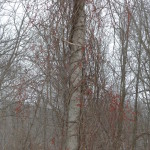A showy winter sight is deep orange to scarlet bittersweet berries dusted by snow. Often they are picked for holiday decorations.
Parts of North America are home to two wild bittersweets. One is a beautiful native that’s in rapid decline. The other is a fast spreading exotic that overwhelms even large trees.
Oriental bittersweet is an aggressive twining vine that can climb a 60 foot tree and smother its foliage. The woody vine is sometimes upwards of four inches in diameter at its base. Oriental bittersweet thrives in open woods that allow sunlight to filter to the forest floor. It grows amazingly fast and produces yellow berries along the vine that split open to reveal scarlet fruits. The plant has bright green leaves are roundish.
In contrast, American bittersweet is neither invasive nor aggressive. Its leaves are oblong, and it produces flowers and fruits at the end of its vine. But, telling the difference between native and Oriental bittersweet is difficult. Buying at nurseries is not recommended.
Aggressive Oriental bittersweet hybridizes with and outcompetes its American relative. Unfortunately, the foreign species is becoming common as the native retreats.
Controlling Oriental bittersweet isn’t easy. Vines can be cut with shears or a hand saw. Small vines can be pulled from the ground, but rootlets remaining in the soil will sprout. Some herbicides will kill it.
People can help contain this aggressive plant by recognizing the difference between the American and Oriental species and not moving the seeds of the latter or using them for decorations.


